Easy Panettone Recipe (Italian Christmas Bread)
This panettone recipe (Italian Christmas bread) produces a rich, buttery, sweet bread, light in texture and studded with a mixture of candied fruit.
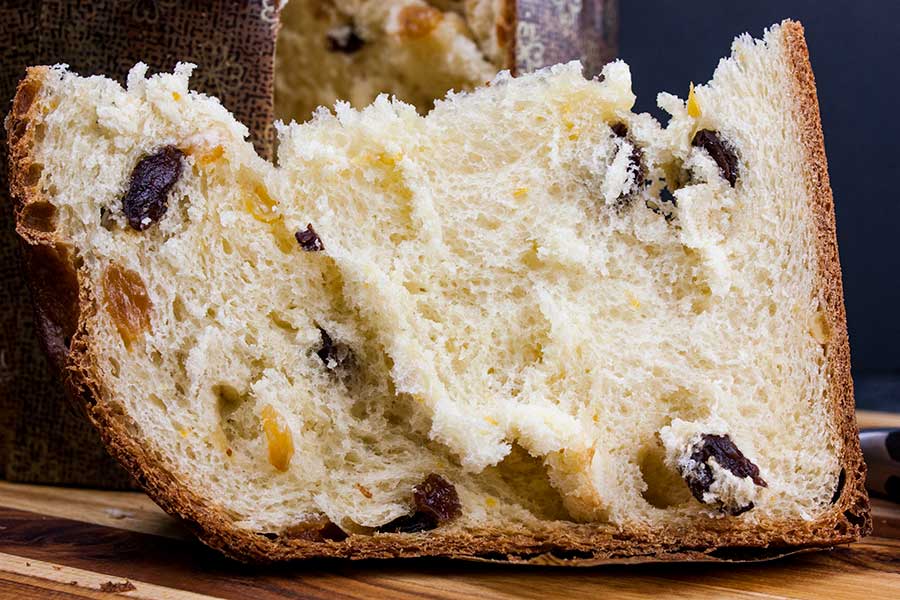
Panettone is a sweet Italian bread traditionally enjoyed during the Christmas holidays.
Of course, this bread was never served during the holidays at our Italian family gatherings. When I mentioned to my aunts that I was going to try and make this bread, I received “what is that?”. UGH!
So, I didn’t have a family recipe that had been passed down for generations and had to do a lot of research to arrive at this recipe I’m sharing with you today.
Try our Chocolate Orange Panettone recipe!
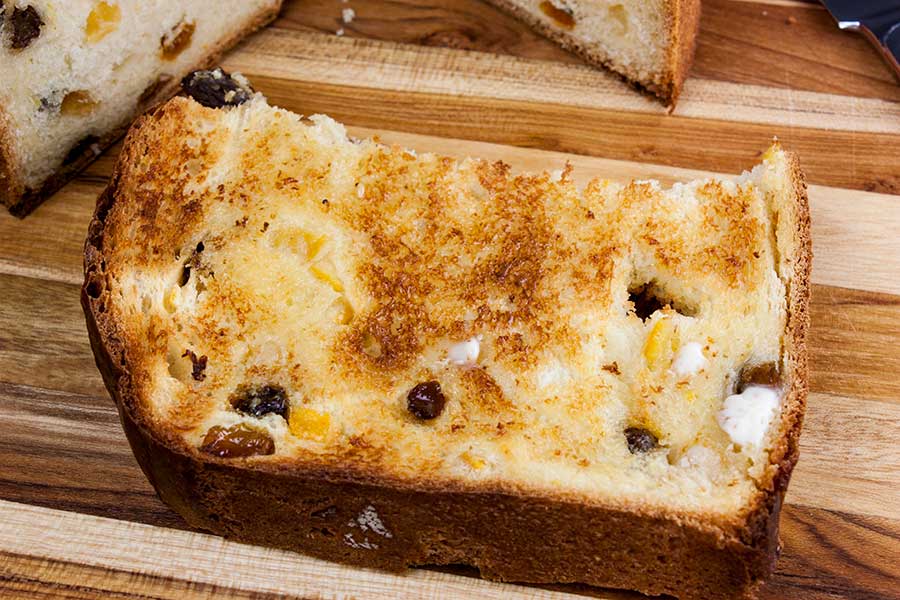
Why You’ll Love This
Fresh from the oven panettone is so much fresher and tastier than store-bought! It’s easy to make once you know how and makes great holiday gifts.
It’s a soft, sweet, buttery brioche-like bread filled with dried fruits and citrus.
I labored over this recipe, so you don’t have to; all you need is patience.
Looking for more delicious Christmas recipes? Try our cut-out eggnog cookies, Italian sesame cookies, Italian fig cookies, Panettone French Toast, and eggnog cheesecake with gingersnap crust.
How to Make a Light and Fluffy Panettone Recipe
I’m a little hesitant to share this recipe with you because it takes patience and planning. This is a three-day panettone bread recipe.
Also, the dough is very sticky and somewhat cumbersome to work with, but if you are determined (like I was), you can turn out a fluffy panettone bread too!
I can’t even count how many panettones I made in testing this panettone recipe. At one point, my husband said, “it’s time to put a bow on this one”. There was no way I was giving up on this panettone recipe!
Don’t Sweat The Recipe is supported by its readers. We may earn a commission if you purchase through a link on our site. Learn more.
Day One ( the night before)
Make the starter by mixing 3/4 cup of all-purpose flour, 1/3 cup water, and 1/8 teaspoon yeast in a medium-sized bowl. Cover and let rise overnight.
The starter will help add volume and flavor and make the finished bread stay fresher for a little longer.
It will end up looking like this:
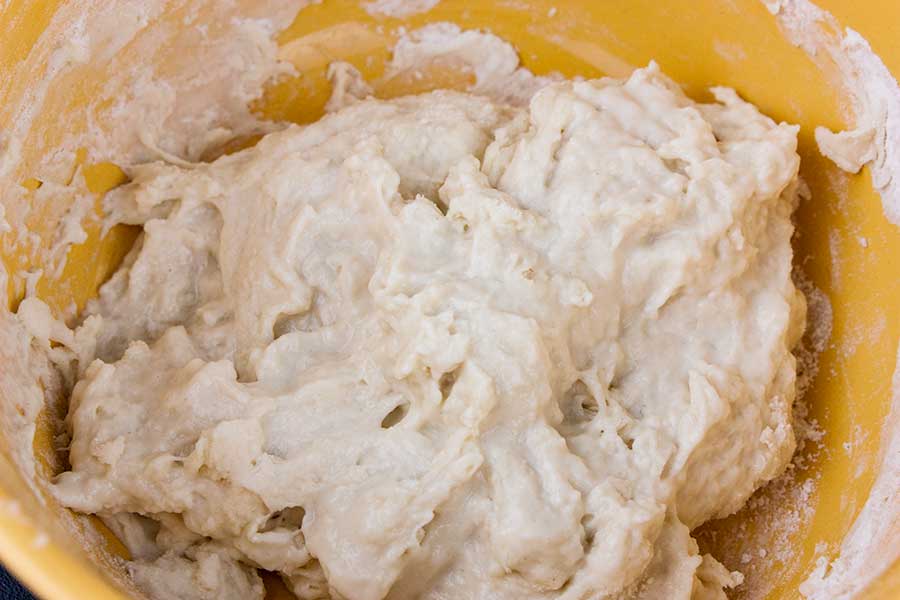
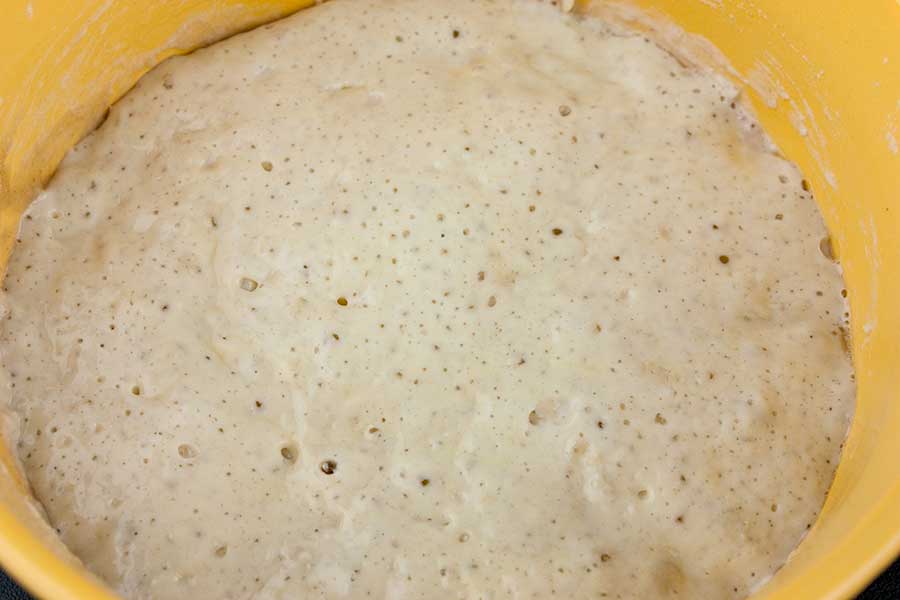
Day two
Measure the flour properly (spoon and swoop) into a medium-size bowl. Whisk the salt into the flour and set aside.
In the bowl of a stand mixer, proof the 2 1/4 teaspoons of yeast with the 1/4 cup of warm (115º degrees F) water for about 5-10 minutes until frothy on top.
Add the eggs, vanilla, sugar, and orange and lemon zest, to the yeast mixture and whisk together.
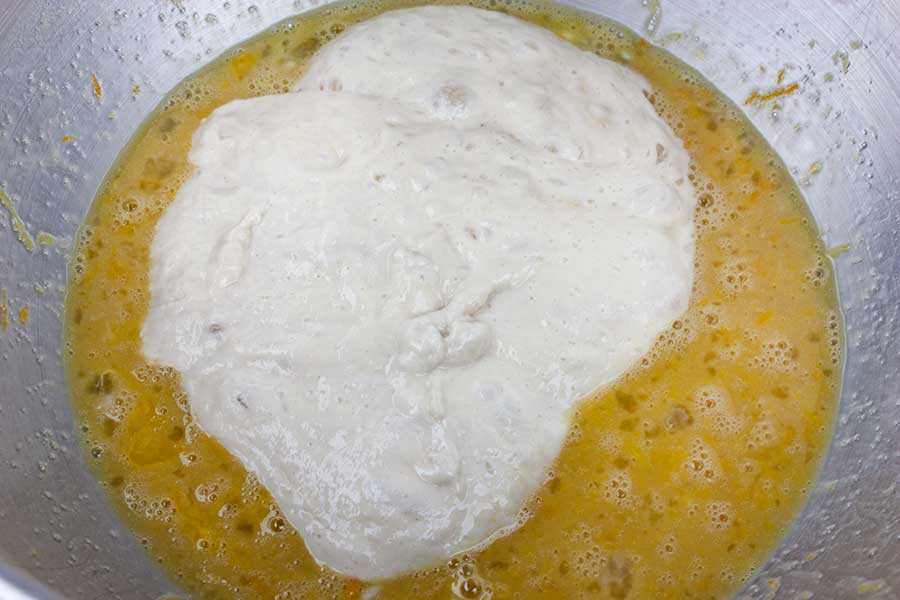
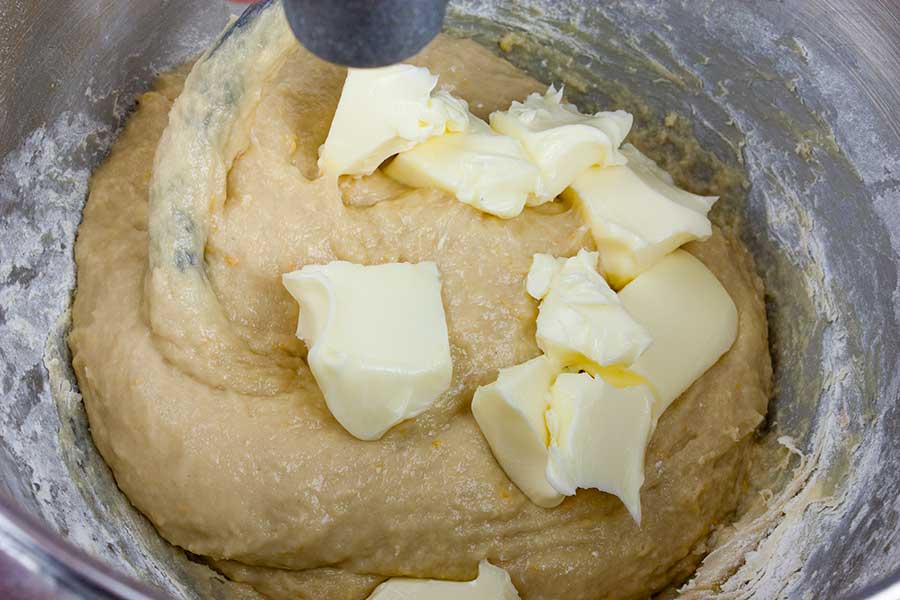
Add the starter and flour, attach the dough hook and mix until it comes together and starts pulling away from the bowl slightly.
Turn the mixer to medium speed and knead for 10-15 minutes or until smooth and elastic. You may need to stop the mixer and scrape down the sides a few times.
This dough will not come together fully and completely pull away from the sides of the bowl like standard white bread dough.
Add the room-temperature butter and knead for about 10-15 minutes or until it’s fully incorporated. Again you may need to scrape down the sides of the bowl.
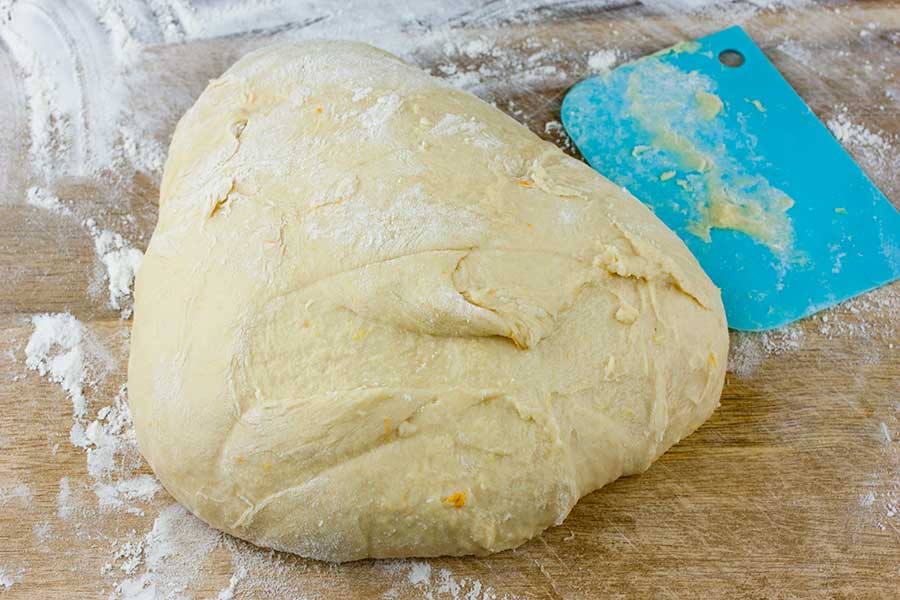
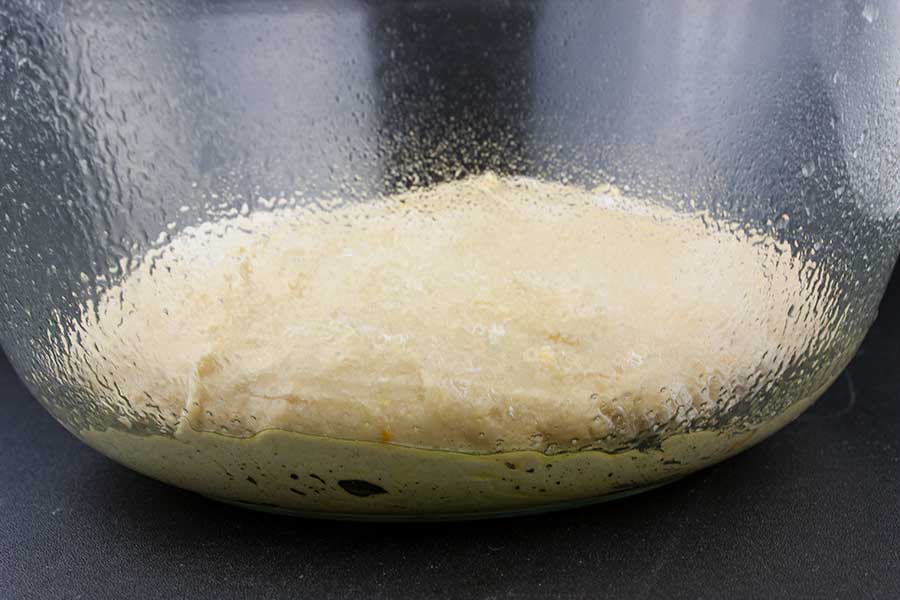
Scrape the dough out onto a lightly floured surface and knead JUST ENOUGH flour into it until it’s not EXTREMELY sticky and slightly easier to handle.
The less flour you can use, the lighter and fluffier your panettone will be once baked.
A bench scraper will help you tremendously with this process. Please don’t add too much flour, and be patient with the dough.
Place the dough in a large oiled bowl. Oil the top of the dough, cover it with plastic wrap, and allow it to rise for 3 to 4 hours or until tripled in size.
The dough-rising process is long. Patience is key.
Don’t go by the time when rising; watch it closely, and move on to the next step once tripled.
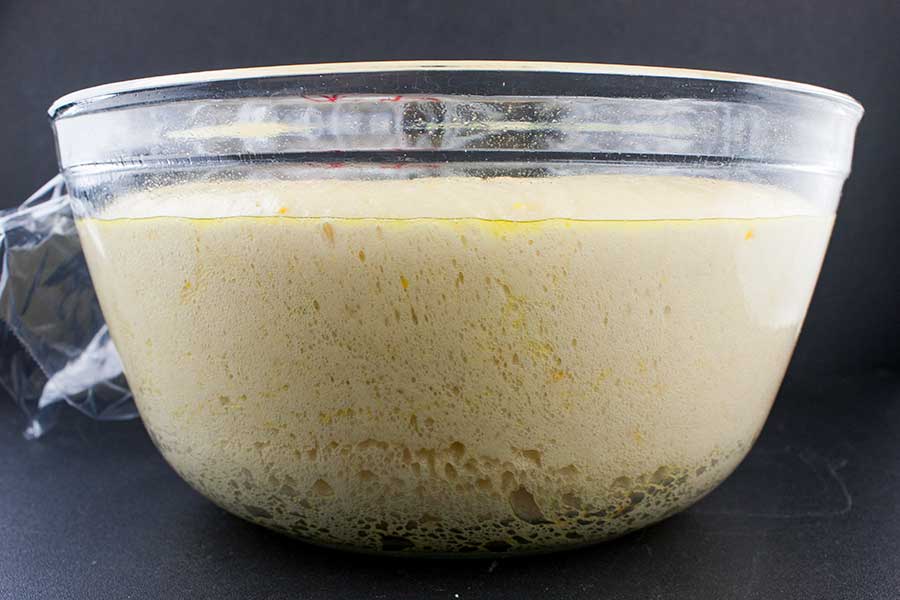
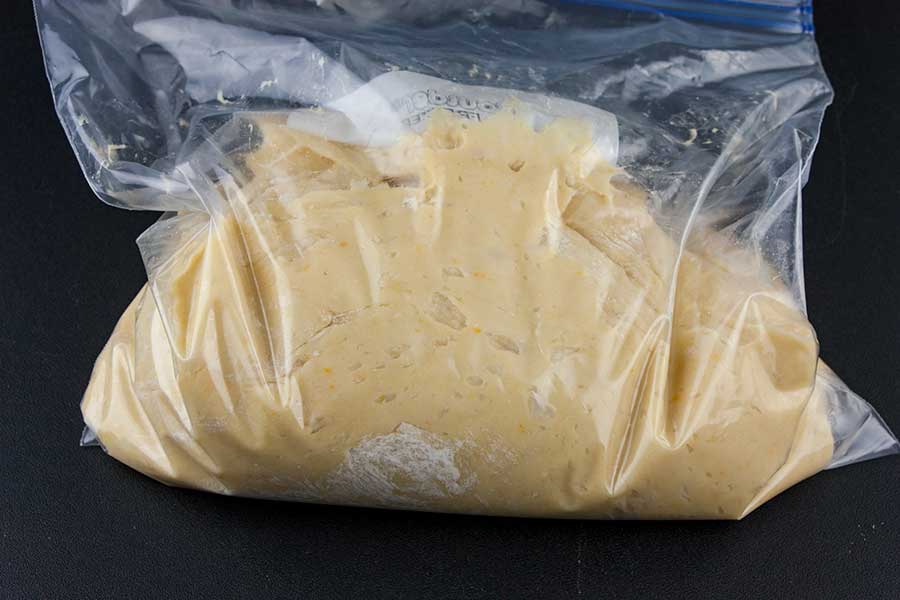
Punch the dough down gently, and remove the dough from the bowl to a lightly floured surface. Again only knead in enough flour to help you handle the dough a little easier.
Place it in a one-gallon zip-top bag or another bowl covered with plastic. Place in the refrigerator overnight. The slow rise in the refrigerator overnight develops more flavor and makes the dough easier to shape.
In a small bowl, combine the dried fruit with the orange liqueur (I use Grand Marnier.) and let soak overnight.
I find the bag much easier to make room in the fridge for and just tear open the sides to remove the dough the next day.
UPDATE: While in the process of writing this post, I decided to try to make this in 2 days. It worked perfectly. So if you don’t have the time to do three days, make the starter early in the morning. Let it sit for at least 6 hours. It needs to be bubbly and risen.
Then make the dough and let it rise for 3-4 hours. Transfer to a plastic zip-lock bag and refrigerate overnight or for at least 12 hours. Then continue with the rest of the steps.
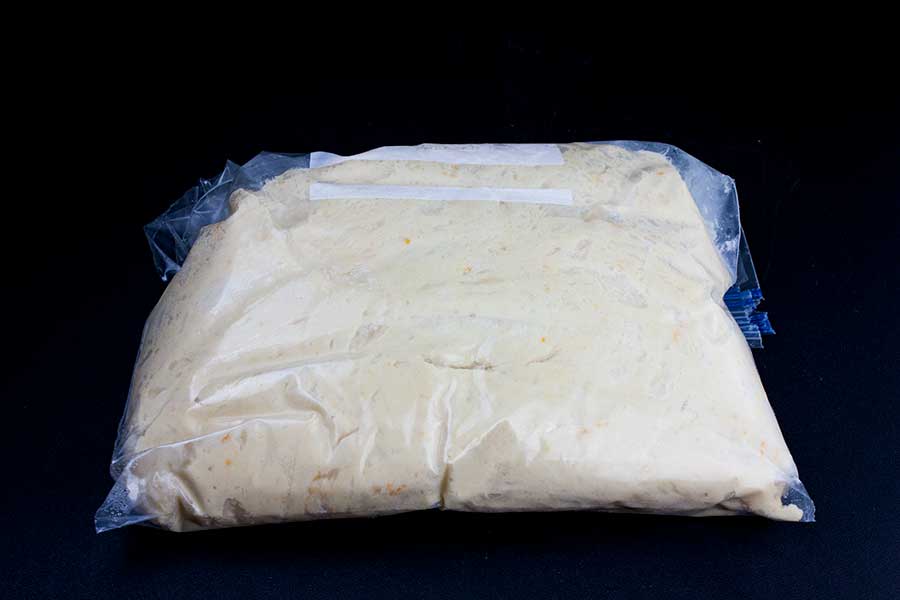
Day Three
It will rise in the refrigerator and look like the above photo. This step helps improve flavor and texture.
If you used a plastic bag, just rip it down the sides to open and place the dough on a very lightly floured surface.
Because the dough is cold, it is MUCH easier to handle during this step and won’t require much flour at all. I have actually done it without any flour, and it worked beautifully.
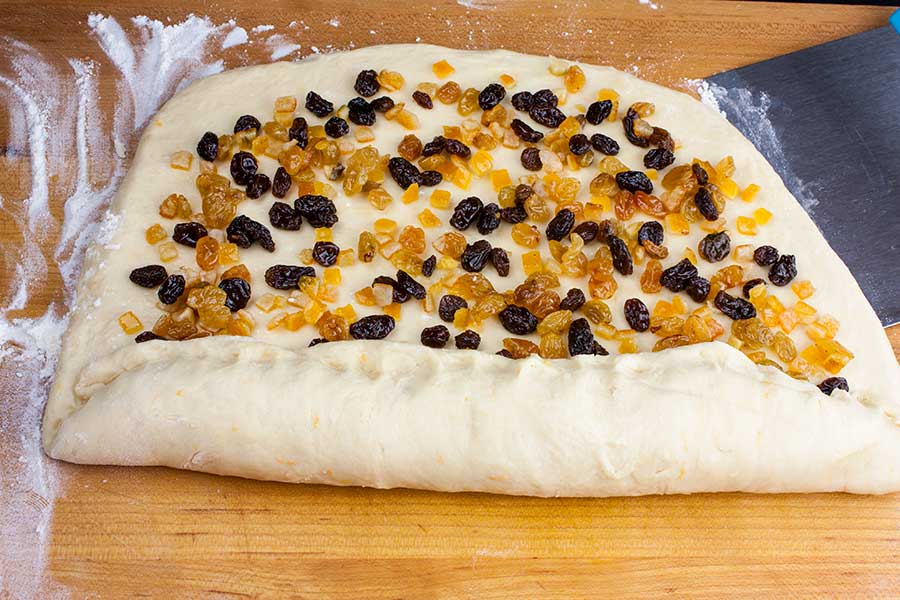
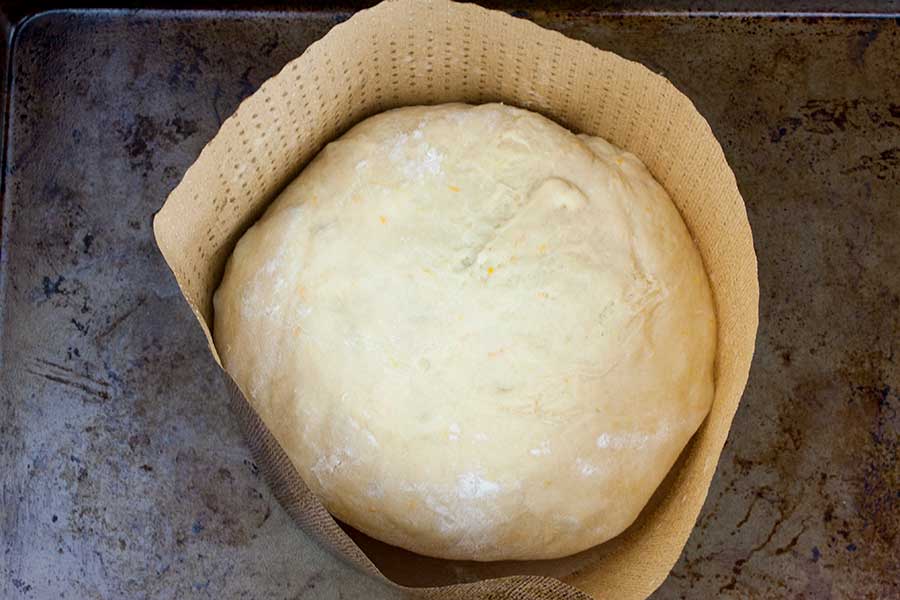
Press and roll the dough out into a rectangle. Drain any extra liqueur from the fruit and sprinkle the soaked raisins and fruit evenly over the dough.
Roll the dough up tightly, folding the ends inwards.
Once rolled, fold the ends into the center and fold and tuck it around to shape the dough into a ball trying to keep a good bit of dough on top.
Transfer the dough into a greased panettone mold (I buy them from Amazon) and place it on a baking sheet. You can also use a metal panettone pan.
Cover with oiled plastic wrap and let the dough rise in a warm place until almost to the top of the paper mold for about 3 to 4 hours or until almost tripled in size again. Remember the dough is cold, so it will take a while to rise.
I keep our house between 65º-68º, which is not ideal for bread making. So while forming the dough, I heat my oven to about 150º, turn it off and turn the oven light on.
Once the dough is formed, I place it in the oven to rise.
In the last couple of panettone testing I made, it only took about 2 1/2 hours for it to rise completely.
Just before it’s completely risen, remove the dough from the oven (if that’s where you placed it to rise) and preheat the oven to 350ºF.
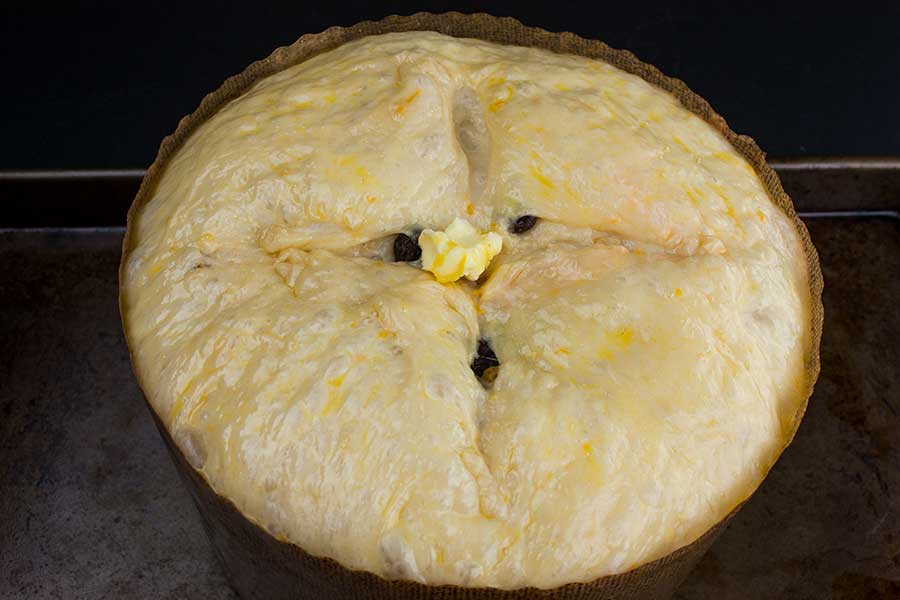
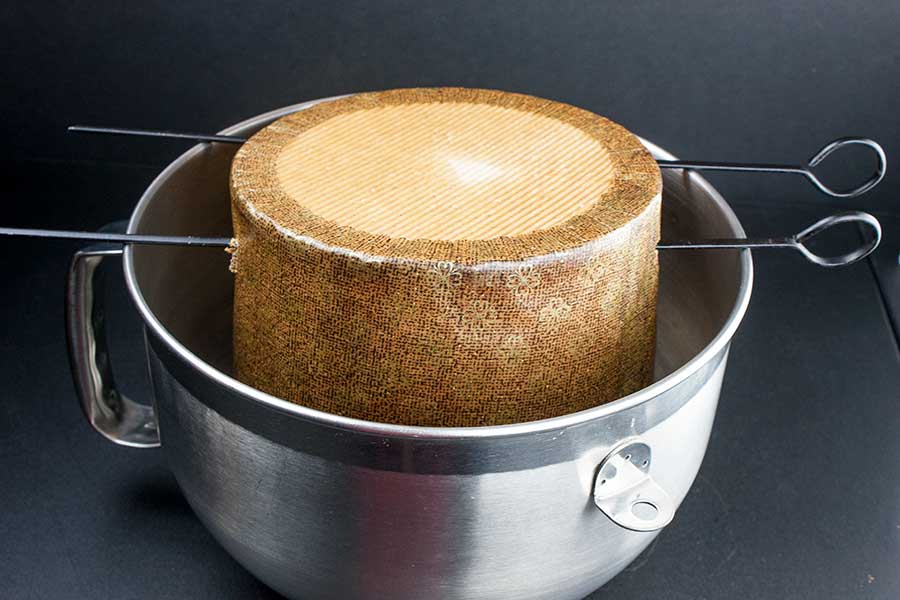
Before baking, brush the dough gently with the egg wash over the entire surface.
Cut a “cross” in the top about 1/4-1/2″ deep with a very sharp knife. Place a dab of softened butter in the center of the cross.
This step will help it rise properly and help achieve the dome shape.
Bake the bread for 40-45 minutes or until a wooden skewer comes out clean.
If it starts to brown too much, lightly tent it with a piece of aluminum foil.
While the bread is baking, prepare a way to hang it upside down to cool. This helps keep its light, fluffy texture and keeps it from falling.
I use the bowl from my stand mixer. If using a bowl, be sure it’s deep enough that the top of the bread isn’t touching the bottom of the bowl.
Once baked, carefully slide two skewers through each side of the bottom of the bread. Turn the panettone upside down into the prepared place to let it cool for at least 2 hours.
I’ve seen people hang the bread between two chairs! Yikes, that scared me, so I opted for the deep bowl.
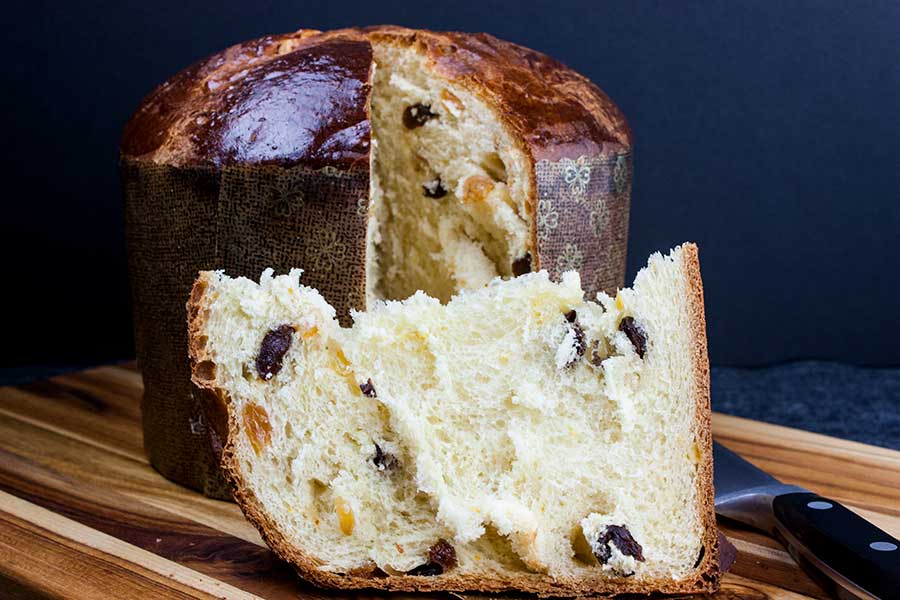
Slice and enjoy the fruits of your three-day baking adventure by making this panettone recipe!
Just look at that light, fluffy bread studded with raisins and candied orange peel (candied citron).
I thoroughly enjoyed making this bread over and over again. I know it’s traditional Christmas bread, but I don’t think I can wait for just once a year.

Our favorite way to eat panettone is toasted and slathered with butter!
Tips
- Panettone is traditionally a long-ferment or sourdough-based bread. You can use the starter recipe in the card below, or if you already have a sourdough starter, you can use that as well. Either works great!
- Avoid adding too much flour. It will make the bread dense. Measure the flour correctly, aerate, spoon, and swoop level.
- Use room-temperature eggs and butter.
- I use good quality European butter for the best panettone. If you are going to go the effort, use good quality ingredients.
- Refrigerating the dough to rise and ferment truly develops a lot more flavor.
- I use metal skewers to hang the bread. I tried wooden ones on my first test panettone, and they started to break. The fear set in, and I immediately switched to metal.
- Using double pans when baking helps to prevent the bottom from browning too much.
- Pierce the cooling bread with two long metal skewers about 1 inch from the base, and hang it upside down to cool completely. This will prevent the bread from collapsing while cooling.
Variations
- Bread flour works great too.
- Mix and match the dried fruits. Use any combination you desire.
- Toss in some semi-sweet chocolate chips.
- Sprinkle the top of the panettone with pearl sugar before baking.
FAQs
Panettone is more bread than cake. It’s a sweet, enriched bread studded with raisins and other dried fruit.
You can slice it into thick or thin wedges and eat it warm or at room temperature. You can toast a piece and slather it with butter.
Slice it up for toast, french toast, or make bread pudding.
Let the bread cool completely, wrap tightly in plastic wrap, and store it at room temperature for up to 5 days. Or refrigerate it for up to a week.
Wrap completely cooled bread tightly in plastic wrap, then in aluminum foil, and freeze for up to 2 months. You can wrap it whole or wrap individual pieces. Thaw in the refrigerator overnight.
More Delicious Pastry Recipes
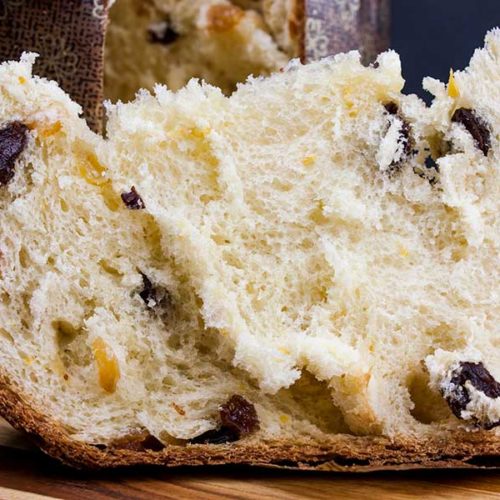
Easy Panettone Recipe (Italian Christmas Bread)
Ingredients
For the Starter
- 3/4 cup all-purpose flour
- 1/3 cup water
- 1/8 teaspoon dry active yeast (a pinch)
For the Dough
- 1/4 cup water warm
- 2 1/4 teaspoons dry active yeast
- 3 large eggs room temperature
- 1/2 cup granulated sugar
- 1 1/2 teaspoon vanilla
- 1 tablespoon orange zest freshly grated
- 1 tablespoon lemon zest freshly grated
- all the starter from above
- 3 cups all-purpose flour (plus more for dusting)
- 1 teaspoon salt
- 6 tablespoons unsalted butter softened
For the Fruit
- 1/2 cup golden raisins
- 1/2 cup dark raisins
- 1/3 cup candied orange peel
- 1/4 cup orange liqueur (such as Grand Marnier)
For the Egg Wash
- 1 large egg beaten
- 1 tablespoon water
A dab of butter for the top just before baking
Instructions
The Starter (day one)
- Mix 3/4 cup of all-purpose flour, 1/3 cup water (or a little more to make the starter thick and somewhat wet but not like a dough consistency), and 1/8 teaspoon yeast in a medium-size bowl. Cover and let rise overnight.3/4 cup all-purpose flour, 1/3 cup water, 1/8 teaspoon dry active yeast
The Dough (day two)
- Measure the flour properly (spoon and swoop) into a medium-size bowl. Whisk the salt into the flour and set aside.In the bowl of a stand mixer, proof the 2 1/4 teaspoons of yeast with the 1/4 cup of warm (115º degrees F) water about 5-10 minutes until frothy on top.Add the eggs, vanilla, sugar, and orange and lemon zest, to the yeast mixture and whisk together.1/4 cup water, 2 1/4 teaspoons dry active yeast, 3 large eggs, 1/2 cup granulated sugar, 1 1/2 teaspoon vanilla, 1 tablespoon orange zest, 3 cups all-purpose flour, 1 teaspoon salt, 1 tablespoon lemon zest
- Add the starter and flour, attach the dough hook and mix until it comes together and starts pulling away from the bowl slightly. Turn the mixer to medium speed and knead for 10-15 minutes or until smooth and elastic. You may need to stop the mixer and scrape down the sides a few times.all the starter from above
- Add the butter and knead for about 10-15 minutes more or until it’s fully incorporated. Again you may need to scrape down the sides of the bowl. The dough should be smooth and elastic but will still be sticky.6 tablespoons unsalted butter
- Scrape the dough out onto a lightly floured surface and knead JUST ENOUGH flour into it until it’s not EXTREMELY sticky and slightly easier to handle. The less flour you can use the lighter and fluffier your panettone will be once baked.
- Place the dough in a large oiled bowl. Oil the top of the dough, cover with plastic wrap and allow to rise 3 to 4 hours or until tripled in size. Once tripled in size gently punch the dough down, remove the dough from the bowl to a very lightly floured surface. Again only knead in enough flour to help you handle the dough a little easier. Place it in a one-gallon zip-top bag or another bowl covered with plastic. Place in the refrigerator overnight.
- In a medium-size bowl marinate the dried golden raisins, dark raisins, and candied orange peel with the orange liqueur. Cover with plastic wrap set aside and stir occasionally.1/2 cup golden raisins, 1/2 cup dark raisins, 1/3 cup candied orange peel, 1/4 cup orange liqueur
Day Three
- Remove the dough from the refrigerator and place on a lightly floured surface. Press and roll the dough out into a rectangle. Sprinkle the marinated fruit evenly over the dough. Roll the dough up tightly into a log shape. Fold the ends into the center and fold and tuck it around to form a smooth ball. Transfer the dough into a greased panettone mold
- Cover with oiled plastic wrap and let rise until almost to the top of the paper mold about 3 to 4 hours. Almost tripled in size again. Remember the dough is cold so it will take a while to rise.
- Just before it’s completely risen, preheat the oven to 350ºF degrees. Brush the dough gently with the egg wash over the entire surface. With a very sharp knife gently cut across the top about 1/4-1/2″ deep and again in the other direction. Place a dab of softened butter in the center of the cross.1 large egg, 1 tablespoon water
- Bake for 40-45 minutes or until a wooden skewer comes out clean. If it starts to brown too much lightly tent with a piece of aluminum foil.
- While the bread is baking prepare a way to hang it upside down to cool. Once baked carefully slide two skewers through each side of the bottom of the bread. Flip it over into the prepared place to let cool at least 2 hours.
Notes
Weigh the ingredients for more accuracy but using the cup measurements also works. Just be sure to aerate, spoon, and swoop level.
Avoid adding too much flour it will make the bread dense. Measure the flour correctly, aerate, spoon, and swoop level.
Using double pans when baking helps to prevent the bottom from browning too much.If it starts to brown too much lightly tent it with a piece of aluminum foil.
Storing – Let the bread cool completely, wrap tightly in plastic wrap, and store it at room temperature for up to 5 days. Or refrigerate it for up to a week.
Freezing – Wrap completely cooled bread tightly in plastic wrap, then in aluminum foil, and freeze for up to 2 months. You can wrap it whole or wrap individual pieces. Thaw in the refrigerator overnight.



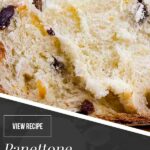
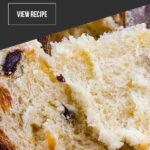

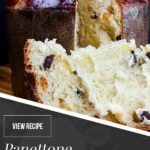


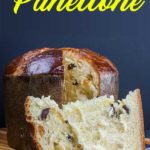
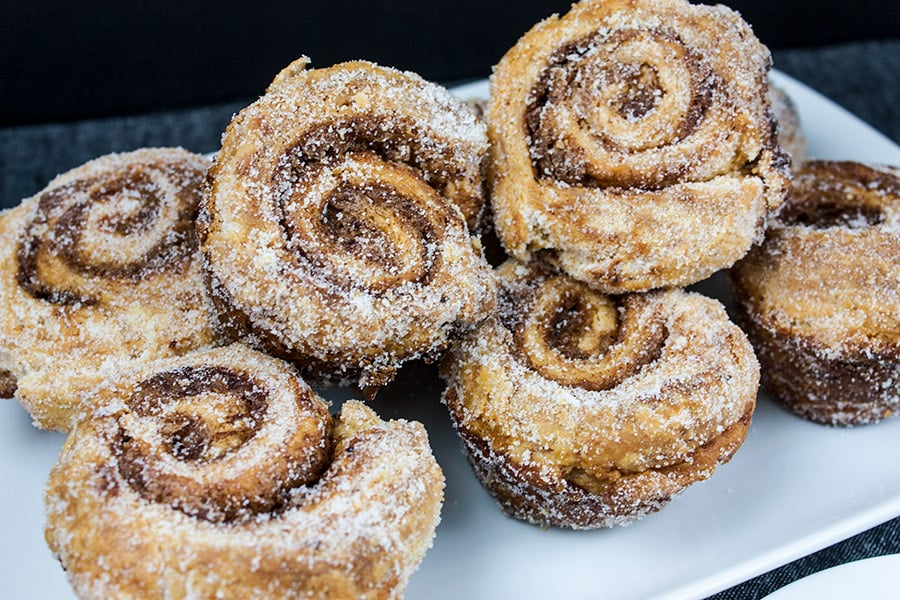
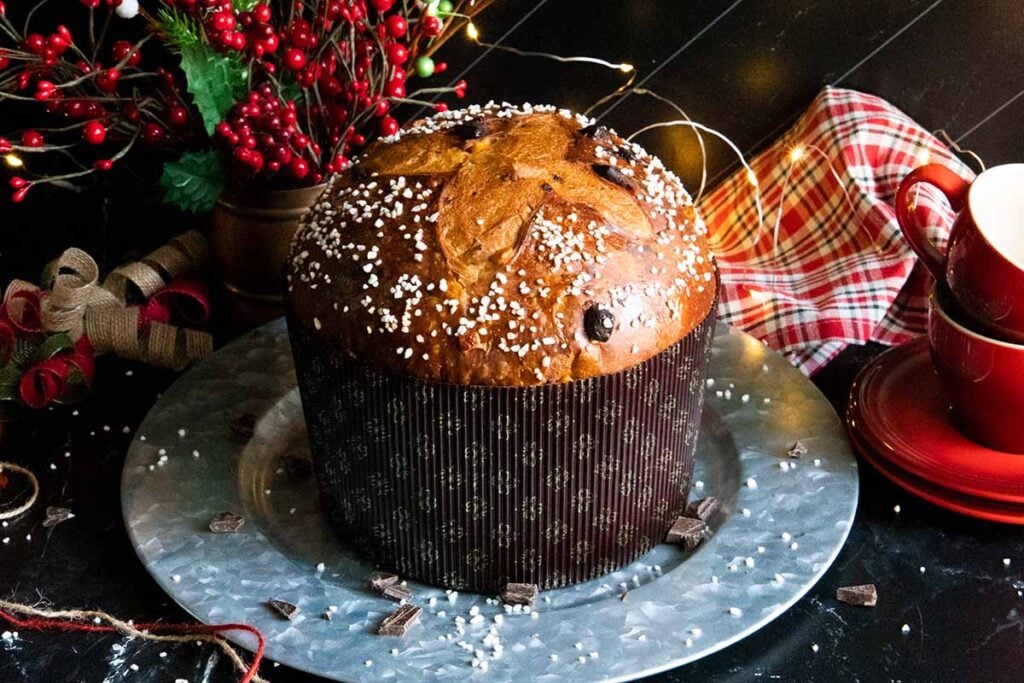
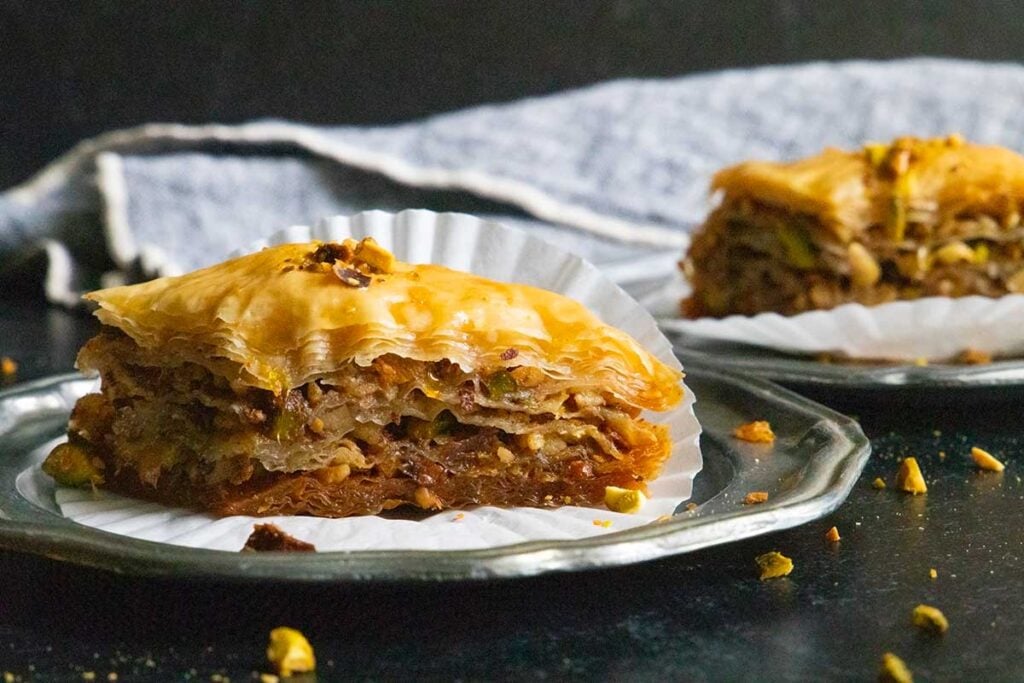
Hi, apologies, just saw your thread that the starter has to sit for at least 6 hours in a warm place.
Hi, thanks for the detailed panattone recipes. I just want to clarify 1 point. For the starter, do I let it rise at room temperature or in the fridge. Thanks.
Thank you for answering my question. I went ahead and used my starter at 3/4 cup. The dough was VERY wet, so I used a bench scraper to handle it and kept my hands off it. It turned out great, very light and fluffy and not too sour. I also used Jamaican Rum which I had instead of orange liqueur which I didn’t have. Thanks for a great recipe. I will definitely make it again.
Thanks so much for stopping by and letting us know how it turned out!
I already have a working sourdough starter. Could I just use that at room temperature? Would I use 3/4 cup of my starter?
Carolyn, I’ve always just made the starter and never tried using my sourdough starter. I’m guessing 3/4 cup will be just fine. Just remember a sourdough starter will be much stronger in sour taste.
Does the starter stay overnight in the fridge or out on the counter?
Out on the counter covered in plastic wrap.
Hi, just in a process of making this.. But I miscalculated the days, third is tomorrow and I need it to be on Wednesday (I’m on 2nd today).. Can I prolong the process for one more day by keeping the dough in the fridge or should I bake it tomorrow (in which case how to prolong the life of a panettone?) Thanks
Hi, Ana. Sorry, this response is late but we were enjoying our holidays. It shouldn’t be a problem to keep it refrigerated one more day. With that said I’ve never done that so please let us know how it turned out.
Made day one starter and when I mixed it the night before it was very dry – is that normal? This morning I woke up and it’s a little bubble but not much and didn’t really grow. Should I do it again? How long does the starter need to sit so I can do it in the morning. Thanks!
Hi, Kristen. The starter should look like the photos in the post. It shouldn’t be too dry and should be as bubbly as the photo. You can make this in 2 days see the update on the recipe post. It needs to be in a warm place for a minimum of 6 hours.
I’m trying it again but used more than a 1/3 cup water to get all mixed. Covered w/ plastic and it’s in oven w pan boiling water below. I’ll check in 6 hrs.
I’m excited to try your expertly explained recipe with detailed photos! A few questions: Panettone is a bread of sorts, so bread flour could work well, too? Would milk be fine to use instead of water? Would adding a bit more yeast cause any issues? Lastly, to keep it light, would you recommend sifting the flour?
Hi, Diana. I can only recommend using the steps and ingredients in our recipe. I have made this repeatedly and it comes out perfect (in my opinion) every time. Feel free to try your suggestions and let us know how it comes out for you! Thanks for stopping by.
Leigh, this looks delicious. I have never had homemade panettone. Your step by step instructions are wonderful too. Thank you so much for being a part of the Hearth and Soul Link Party Community.
How can I get this bread am in abudabi
I’m sorry but this is a recipe not a product for sale.
Hi Leigh,
Great recipe i’m a big fan of Panettone. I’m trying to make a gluten free version of this recipe but it seems it’s not working..
Do you have any suggestion that would help me achieve the right texture of this panettone?
Thank you
Hey Maria! I don’t have any experience with gluten-free baking but I googled and found this that might help. https://www.tasteofhome.com/article/converting-recipes-to-gluten-free/ Please do come back and tell us how and if it worked for you. 🙂